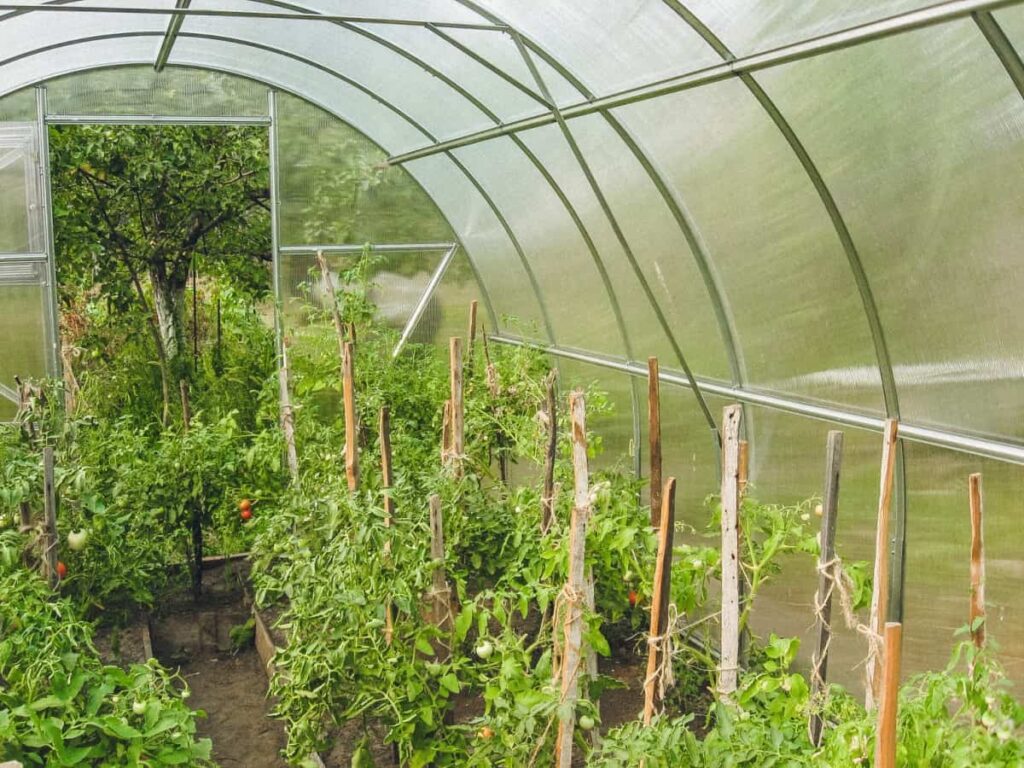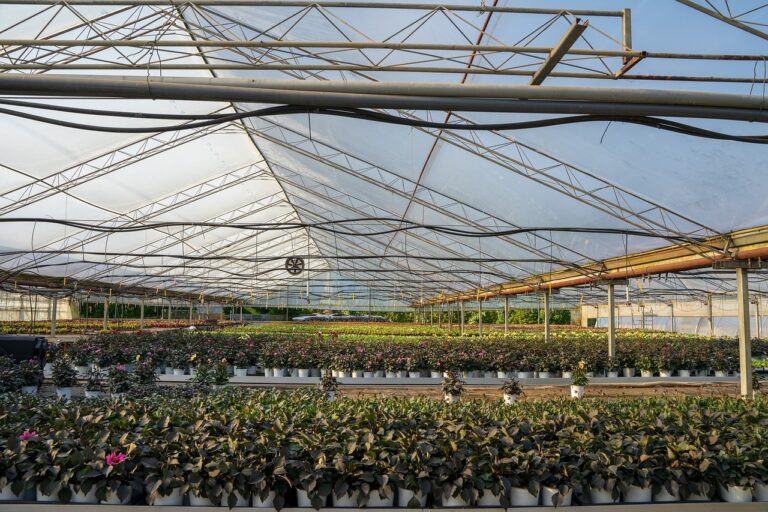I’m standing amidst rows of vibrant green plants, bathed in soft, diffused sunlight, inside a greenhouse. The air is warm and filled with the earthy scent of growing things. It’s a scene that’s both peaceful and promising.
But as I gazed around, I couldn’t help but wonder, are greenhouses really as idyllic as they appear, or do they have a dark side hidden behind those transparent walls? Join me on this journey of discovery as we peel back the layers and explore the question: Are greenhouses bad?
Greenhouses are not inherently bad; they offer benefits like controlled crop production and resource efficiency. However, their environmental impact varies depending on factors such as energy use, plastic usage, land use, and pollution. Sustainable practices, such as using renewable energy and efficient resource management, can mitigate their negative effects and make them valuable tools in agriculture.
What Is the True Environmental Impact of Greenhouses?

The true environmental impact of greenhouses remains a subject of intricate scrutiny, as their benefits and drawbacks converge in a complex ecosystem.
Definition and Purpose of Greenhouses
Definition: Greenhouses are enclosed structures made primarily of glass or plastic that are designed to create a controlled environment for plants. They trap heat from the sun, creating a warmer climate than the surrounding area, which allows for the cultivation of plants that wouldn’t thrive in the local climate.
Purpose:
- Plant Growth: The primary purpose of greenhouses is to provide an ideal environment for plant growth. This includes maintaining temperature, humidity, and light levels.
- Research and Experimentation: Greenhouses are used for scientific research, allowing scientists to study plant behavior in controlled conditions.
- Propagation: Greenhouses are also essential for propagating plants from seeds, cuttings, or grafts.
Historical Context
- Ancient Origins: The concept of greenhouses dates back to ancient Rome, where Emperor Tiberius used movable transparent stone to grow out-of-season cucumbers.
- Renaissance Era: Greenhouses became more prominent in Europe during the Renaissance, with the development of more sophisticated glass structures.
- 19th Century: The 19th century saw the mass production of glass, making greenhouses more affordable and accessible.
Types of Greenhouses
- Traditional Greenhouses: These are the most common type, characterized by their glass or plastic walls and roof.
- High-Tunnel Greenhouses: These are smaller, less permanent structures often used for season extension.
- Polytunnel Greenhouses: Similar to high tunnels but made of polyethylene plastic.
- Lean-to Greenhouses: Attached to an existing structure, such as a house or barn.
- Dome Greenhouses: Geodesic domes that provide efficient insulation and unique aesthetics.
- Hydroponic Greenhouses: Designed specifically for soilless growing systems.
Their Role in Modern Agriculture
- Year-round Production: Greenhouses enable year-round cultivation of crops by maintaining stable temperatures, which is crucial for meeting consumer demand for fresh produce.
- Crop Protection: They protect plants from adverse weather conditions, pests, and diseases, reducing the need for chemical interventions.
- Resource Efficiency: Modern greenhouses incorporate technologies like drip irrigation, automatic climate control, and energy-efficient lighting, making them resource-efficient.
- Sustainable Practices: Some greenhouses employ sustainable practices, such as rainwater harvesting and solar energy, to reduce their environmental footprint.
What Is the True Environmental Impact of Greenhouses?
Understanding the complex and multifaceted environmental impact of greenhouses.
Positive Aspects of Greenhouses
Improved Crop Yields: Greenhouses significantly enhance crop yields by providing optimal conditions for growth, resulting in more efficient food production and reduced food scarcity.
Extending Growing Seasons: Greenhouses extend growing seasons, allowing farmers to produce crops out of their traditional season, which can lead to increased income and more diverse produce.
Negative Aspects of Greenhouses
Energy Consumption: Greenhouses require substantial energy for temperature regulation, especially in colder climates. This reliance on energy sources can contribute to carbon emissions.
Resource Usage (Water, Land, Materials): Greenhouses consume water for irrigation and require land for construction, potentially encroaching on natural habitats. Additionally, the materials used in greenhouse construction can have environmental implications, depending on their source.
Waste and Pollution: The disposal of plastic coverings, old greenhouse materials, and excess chemicals can lead to waste and environmental pollution.
Impact on Biodiversity: Large-scale commercial greenhouses can disrupt local ecosystems and biodiversity by altering local climates and water usage patterns.
The Debate: Are Greenhouses Bad for the Environment?
Assessing the environmental implications of greenhouses is a multifaceted task, requiring a careful examination of their various impacts and benefits.
Arguments in Favor of Greenhouses
Food Security: Greenhouses play a crucial role in ensuring food security by enabling year-round production and reducing the impact of weather-related crop failures.
Efficiency: Greenhouses are more resource-efficient compared to traditional open-field farming, as they use less water, require fewer pesticides, and produce higher yields.
Reduced Food Miles: They allow for local production of fresh produce, reducing the carbon footprint associated with transporting food over long distances.
Research and Innovation: Greenhouses provide controlled environments for research and innovation in agriculture, leading to advancements in crop breeding and disease resistance.
Arguments Against Greenhouses
Energy Intensive: The energy required to maintain controlled temperatures and lighting in greenhouses can be substantial, especially in regions with harsh climates. This reliance on energy sources contributes to greenhouse gas emissions.
Resource Consumption: Greenhouses consume resources like water and land, which could have negative environmental impacts, especially if not managed sustainably.
Plastic Waste: Many greenhouses use plastic coverings that have a finite lifespan and can contribute to plastic waste when disposed of improperly.
Biodiversity Impact: Large-scale monoculture in greenhouses can negatively affect local biodiversity by displacing native flora and fauna.
Balancing the Pros and Cons
Balancing the environmental impact of greenhouses requires a comprehensive approach:
Sustainable Practices: Encouraging the adoption of sustainable greenhouse practices can mitigate their negative effects.
Energy Efficiency: Promoting energy-efficient technologies and renewable energy sources can reduce the carbon footprint of greenhouse operations.
Regulation: Governments and industry standards can play a role in setting guidelines for responsible greenhouse management.
Research and Innovation: Continued research can lead to more environmentally friendly greenhouse technologies and practices.
How Can Mitigation and Sustainable Practices Improve Greenhouse Farming?

Exploring the potential of mitigation strategies and sustainable practices to enhance the environmental footprint of greenhouse farming.
Energy-Efficient Greenhouse Designs
Double-Layer Insulation: Using double layers of glazing or polyethylene film can improve insulation, reducing heating and cooling energy requirements.
Passive Solar Design: Designing greenhouses to maximize natural light and heat can reduce the need for artificial lighting and heating.
Energy Curtains: Installing energy curtains or shade systems helps regulate temperature and reduce energy consumption.
Sustainable Materials and Practices
Recycled Materials: Using recycled and eco-friendly materials for construction and coverings can reduce the environmental impact.
Integrated Pest Management (IPM): Implementing IPM strategies can minimize the use of pesticides and promote natural pest control.
Organic Farming: Some greenhouses adopt organic farming practices, which reduce the use of synthetic chemicals and promote soil health.
Alternative Energy Sources
Solar Power: Installing solar panels on greenhouse roofs can provide renewable energy to offset electricity consumption.
Geothermal Heating: Utilizing geothermal energy for heating and cooling can be an energy-efficient alternative.
Wind and Biomass: In some regions, wind turbines and biomass boilers can provide sustainable energy sources.
Water Conservation Methods
Drip Irrigation: Drip irrigation systems deliver water directly to plant roots, reducing water wastage.
Rainwater Harvesting: Collecting and storing rainwater can be used for irrigation, reducing reliance on freshwater sources.
Water Recycling: Implementing systems to capture and reuse excess irrigation water can further reduce water consumption.
FAQ’s
What are the negatives of a greenhouse?
Greenhouses can require significant maintenance, including controlling temperature and humidity. They can also be expensive to set up and may lead to pest or disease issues if not managed properly.
Can the greenhouse effect be harmful?
The natural greenhouse effect is essential for Earth’s climate, but an enhanced greenhouse effect due to human activities can lead to global warming and climate change, which are harmful.
Is it worth having a greenhouse?
Whether a greenhouse is worth it depends on your gardening goals and commitment. It provides a controlled environment for year-round growing, but it also demands time, effort, and investment.
Why do greenhouses fail?
Greenhouses can fail due to inadequate temperature control, poor ventilation, pest infestations, or neglect. Successful greenhouse gardening requires attention to detail.
Is indoor or greenhouse better?
The choice between indoor and greenhouse gardening depends on your space, climate, and goals. Greenhouses offer natural light but require more space and investment, while indoor setups are more controlled but may need artificial lighting.
Is indoor better than a greenhouse?
“Better” depends on your specific needs. Indoor gardening provides more control but may limit plant variety. Greenhouses offer natural light but require more space and upkeep. Choose based on your priorities.
Final Words
In conclusion, after delving into the multifaceted discussion surrounding greenhouses and their environmental impact, I find myself acknowledging the complexity of this issue. Greenhouses undeniably offer substantial benefits in terms of food security, resource efficiency, and technological innovation, all of which are essential for addressing the challenges of a growing global population.
However, their energy-intensive operations, resource consumption, plastic waste, and potential biodiversity impacts cannot be ignored. It becomes evident that the key lies in striking a balance.
Through sustainable practices, energy-efficient designs, and responsible management, we can mitigate the negative effects of greenhouses while harnessing their potential for year-round food production and research. In an era of climate change and shifting agricultural needs, greenhouses can be a valuable tool, provided we continue to innovate and prioritize environmental responsibility in their use.
I am hopeful that the future of greenhouses will be one where we not only meet our food demands but also protect and preserve the fragile ecosystems of our planet.

